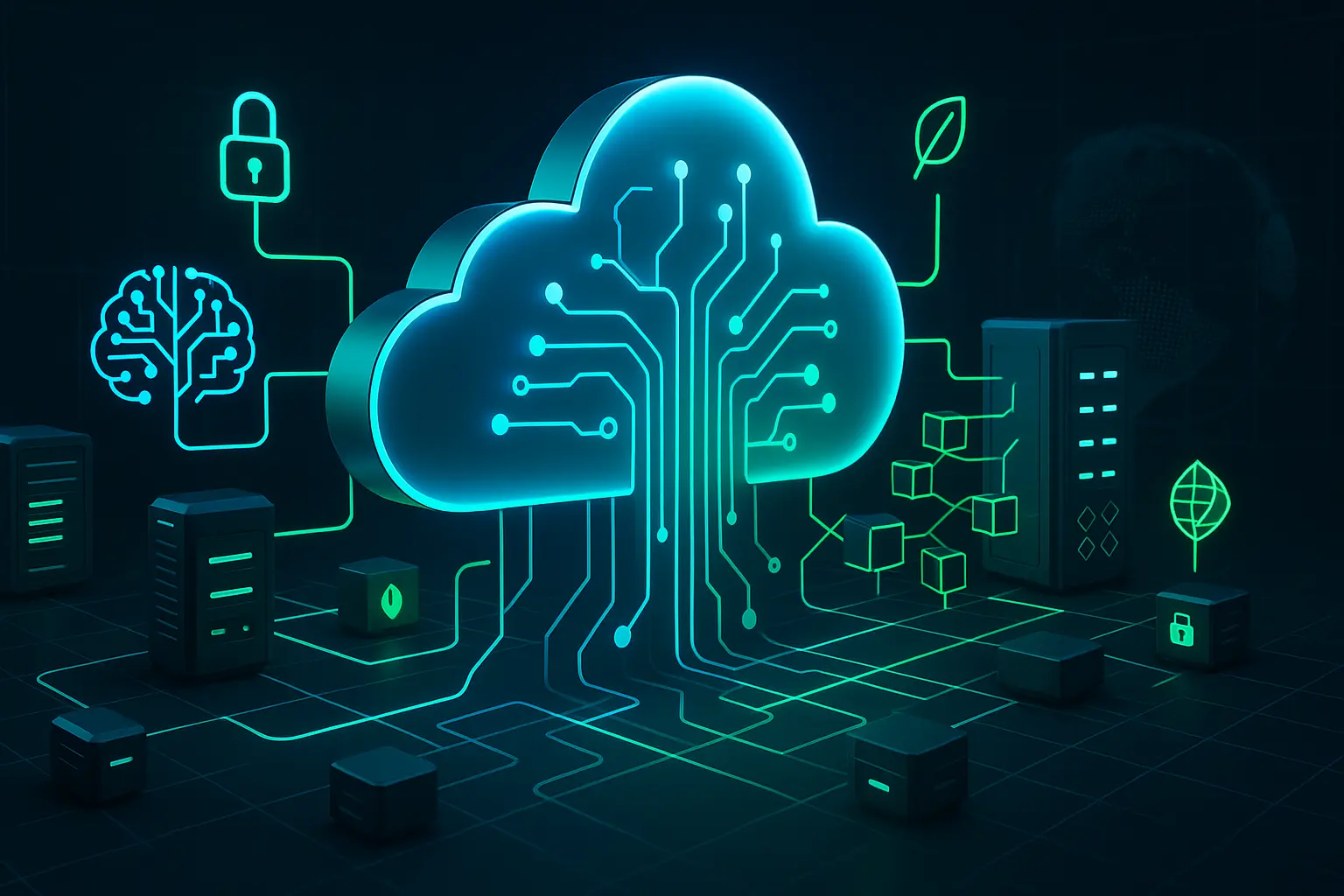Introduction
Picture this: you’re on a mountain trail, smartphone in hand, snapping photos—and before you can even finish your hike, they’re safely stored and synced across your devices.
That’s the power of Cloud Storage today. But what awaits in its future? As data volumes soar and new technologies emerge, cloud storage is set for transformative growth. In this post, we’ll explore how AI, edge computing, decentralized models, and sustainability will shape what comes next for Cloud Storage.
Table of Contents
Market Outlook & Key Players
By 2025, enterprises will store over 100 zettabytes of data—halving the world’s information in the cloud alone cloudzero.com. Giants like AWS, Microsoft Azure, and Google Cloud will continue to dominate, fiercely competing on pricing, reliability, and feature sets simplilearn.com. Meanwhile, specialized providers (e.g., IDrive, Sync.com) will carve niches around security and affordability.
| Provider | Strength | Focus |
|---|---|---|
| AWS | Scalability & Ecosystem | Enterprise-grade services |
| Azure | Integration with Microsoft 365 | Hybrid cloud solutions |
| Google Cloud | Data analytics & AI tools | Big data, machine learning |
| IDrive | Cost-effective large plans | Personal & SMB backups |
| Sync.com | Zero-knowledge encryption | Privacy-focused storage |
Table 1: Leading cloud storage providers and their core differentiators.
Top Trends Shaping Cloud Storage
1. AI‑Driven Storage Management
Artificial intelligence isn’t just for recommendations—it’s optimizing how and where you store data. According to Forrester, adoption of AI-powered cloud services will jump 40% by 2025 as more enterprises leverage predictive analytics to manage storage tiers and forecast capacity needs wipro.com.
2. Zero‑Trust Security Model
Cyber threats are evolving, and trusting the perimeter is no longer enough. The Zero‑Trust framework enforces identity verification for every user and device, encrypts data in transit and at rest, and employs continuous risk assessment—standards that top cloud providers are now integrating by default gamiapp.io.
3. Edge Computing & Low‑Latency Storage
With 75+ billion IoT devices predicted by 2025, processing data near its source is critical cloudzero.com. Hybrid edge-cloud ecosystems reduce latency for applications like autonomous vehicles, smart manufacturing, and AR/VR streaming, while central clouds handle archival and large-scale analytics techrepublic.com.
4. Decentralized Storage Networks
Blockchain-based storage (e.g., IPFS, Sia) is pioneering decentralized Cloud Storage, distributing chunks of encrypted data across multiple nodes. This approach minimizes single points of failure, boosts privacy, and offers pay‑as‑you‑go economics compared to traditional models gamiapp.io.
5. Sustainability & Green Data Centers
Data centers are energy‑hungry—consuming roughly 1% of global electricity. Leading providers are transitioning to renewable power, deploying AI-driven cooling, and designing modular data halls to lower carbon footprints. Expect carbon-neutral cloud storage plans to become mainstream.
Comparing Storage Models: Centralized vs. Decentralized
| Feature | Centralized Cloud (AWS/Azure) | Decentralized Cloud (IPFS/Sia) |
|---|---|---|
| Availability | 99.99% SLAs | Variable; incentivized uptime |
| Security | Enterprise-grade encryption | Zero-knowledge, blockchain‑secured |
| Cost Structure | Subscription tiers | Pay-per-use, micro-payments |
| Data Sovereignty | Region‑based controls | Global, peer-to-peer distribution |
| Scalability | Auto-scaling | Depends on network participation |
Table 2: Key differences between centralized and decentralized Cloud Storage.
Innovations on the Horizon
AI‑Powered File Organization & Retrieval
Natural Language Processing (NLP) will let you “ask” your storage, “Show me last month’s financial reports.” Auto-tagging, context-based search, and workflow automation will save hours of manual data management.
Quantum Encryption for Ultimate Security
Quantum Key Distribution (QKD) promises near‑unbreakable links. While still emerging, partnerships between cloud providers and quantum hardware vendors are laying groundwork for quantum‑resistant Cloud Storage.
5G‑Optimized Sync & Backup
As 5G rolls out globally, uploading large media files will be seamless. Real-time collaboration on high‑resolution video editing, for example, will feel like local disk access.
Cloud Storage Meets Virtual Reality
Massive VR worlds and holographic telepresence require petabyte‑scale, low-latency storage. Expect specialized “VR buckets” with optimized content delivery networks (CDNs) tailored for immersive applications.
Automated Disaster Recovery & FinOps
FinOps teams are rising to manage spiraling storage costs—60% of enterprises now have dedicated FinOps functions info.flexera.com. AI-driven backup policies will automatically trigger geo-replication, versioning, and cost alerts based on usage patterns.
Preparing for Tomorrow: Actionable Strategies
Whether you’re an IT leader or a savvy individual user, here’s how to stay ahead:
- Enable Zero‑Trust Everywhere
- Implement MFA, micro‑segmentation, and continuous monitoring.
- Learn more in our Cloud Security guide.
- Adopt a Multi‑Cloud or Hybrid Strategy
- Balance workloads across providers to optimize cost and performance.
- Use abstraction layers (e.g., Kubernetes, Anthos) for portability.
- Invest in Edge‑Cloud Architectures
- Deploy mini‑data centers or caching nodes near critical operations.
- Leverage edge runtimes like AWS IoT Greengrass, Azure IoT Edge.
- Leverage AI for Cost & Capacity Planning
- Use predictive analytics tools (e.g., CloudZero, Native FinOps).
- Automate tiered storage to shift cold data to cheaper classes.
- Prioritize Sustainability
- Choose providers with renewable‑energy commitments.
- Advocate for carbon reporting and energy‑efficient SLAs.
FAQs
Q1: What is the difference between cloud backup and cloud storage?
A: Cloud backup focuses on copying and restoring files, while cloud storage is a general repository for active data, collaboration, and archiving.
Q2: How secure is decentralized cloud storage?
A: Decentralized networks use encryption and distributed consensus—making data breaches harder but requiring nodes to maintain uptime.
Q3: Will quantum encryption be standard by 2025?
A: Widespread adoption is limited by hardware maturity. Expect pilot programs in regulated industries (e.g., finance, defense).
Q4: How does edge computing reduce cloud storage costs?
A: By processing and filtering data locally, only essential data is sent to central cloud storage, cutting bandwidth and retrieval fees.
Q5: What role does AI play in future cloud storage?
A: AI optimizes capacity planning, automates data lifecycle management, and enhances search and security operations.
Conclusion & Call‑to‑Action
The future of Cloud Storage is a tapestry woven from AI, edge computing, decentralized architectures, and unwavering security. As 2025 approaches, businesses and individuals must evolve their strategies—embrace zero‑trust, diversify across clouds, and adopt AI-driven management.
🚀 Ready to future‑proof your data? Share your thoughts below, explore our Cloud Computing guide, or subscribe for monthly insights on navigating the evolving world of cloud technology!
References:
- Statistics on data growth and IoT forecasts cloudzero.com
- Forrester’s AI-driven cloud adoption report wipro.com
- Flexera’s FinOps findings info.flexera.com
- Insights from Pure Accelerate 2025 itpro.com
- Industry trend analysis on decentralized storage gamiapp.io
- Competition landscape by Simplilearn simplilearn.com





[…] The Future of Cloud Storage in 2025: Trends, Innovations & Insights […]